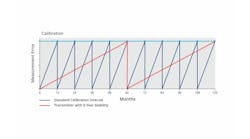Recovering from the economic downswing, process industries got back on track and temperature transmitter shipments saw positive growth in 2011. This recovery in the temperature transmitter market was mainly due to an increase in orders from growing industries such as oil and gas, chemical and electric power. The continued emphasis on plant asset management (PAM) and fieldbus technology also proved to be a strong growth enabler for smart temperature transmitters, according to a new ARC Advisory Group market research study, "Temperature Transmitter Worldwide Outlook"
Manufacturers have begun to realize the cost saving benefits of implementing HART and digital protocol standards to enable PAM solutions, particularly in the maintenance and operation phase of the asset's lifecycle. Growth and spending for plant asset management systems continue to outpace that of the automation industry in general as end users seek to reduce maintenance costs and increase production availability using tools, such as predictive diagnostics and software-based configuration solutions.
When most parts of the world are struggling with weak economic recovery, business opportunities are maximum in the global regions that are experiencing the highest industrial and infrastructure growth, such as BRIC (Brazil, Russia, India, China), MIST (Mexico, Indonesia, South Korea, Turkey), and MENA (Middle East, North Africa) countries. The BRIC and MIST countries are among the 20 countries with the highest GDPs and are expected to grow significantly faster than the developed countries. These growth regions continue to draw investment from around the world and are witnessing significant industrial expansion and improvement in manufacturing operations.
On the path of rapid industrialization, Latin America and Asia have huge demand for energy. In Brazil, the exploration of pre-salt oil fields has spurred huge development projects in the region. The depth of these oil fields presents a huge technological challenge and current investment in pre-salt exploration is only a small fraction of the overall investment required. The whole project is estimated to require around trillion dollars of investment. China, the second largest consumer of oil in the world, is now trying to decrease its dependence on imported oil. To achieve this, the country is focusing on domestic exploration and production activities.
China and India are among the countries with high GDP growth. However, these countries have experienced slower growth in recent times. China's GDP growth in Q2 of 2012 was 7.6 percent; the first time this number has been below 8 percent in the last three years. India's GDP growth has fallen to 5.3 percent in Q1 of 2012 from 6.1 percent in Q4 of 2011.
"Owing to increase in wages, land prices, taxes, and regulations, several industries are moving from China and India to other low cost regions, such as Indonesia, Vietnam, etc. Hence, it is important that suppliers should also focus on other developing high growth regions as well. In this tough economy, diversification will be a key to success as it will help suppliers protect their interests against various country/region specific risks by doing business globally," according to ARC Research Analyst Inderpreet Shoker, principal author of the study.
OTS Market to Also Grow
According to a separate ARC study, the operator simulation training (OTS) market is expected to grow at a compound annual growth rate (CAGR) of over 9% over the next five years. The market was over $450 million in 2012. It is expected to continue to expand through 2017, according to a new study by the ARC Advisory Group.
"The OTS market is at a pivot point with factors that all lead to an expanding market for the operator training simulation solutions for the process industries, particularly in the nuclear, oil and gas, and metals and mining industries. Key trends such as the aging workforce, the new digital generation worker, emerging market workers, safety and risk avoidance factors are all pointing towards OTS market growth," according to Janice Abel, principal consultant, ARC Advisory Group and author of the study.
She went on to say that decisions being made at the management and corporate level, notably in the nuclear, oil and gas, metals and mining, and other sectors, are to invest in operator training to reduce risks and increase safety and performance.



